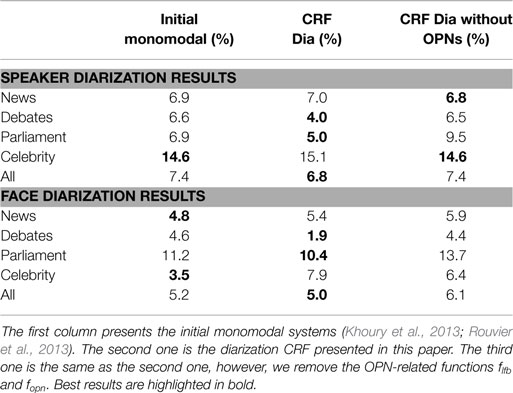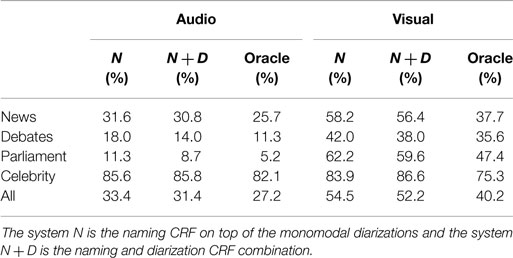CRF-Based Context Modeling for Person Identification in Broadcast Videos
- 1LIUM Laboratory, Le Mans, France
- 2Idiap Research Institute, Martigny, Switzerland
We are investigating the problem of speaker and face identification in broadcast videos. Identification is performed by associating automatically extracted names from overlaid texts with speaker and face clusters. We aimed at exploiting the structure of news videos to solve name/cluster association ambiguities and clustering errors. The proposed approach combines iteratively two conditional random fields (CRF). The first CRF performs the person diarization (joint temporal segmentation, clustering, and association of voices and faces) jointly over the speech segments and the face tracks. It benefits from contextual information being extracted from the image backgrounds and the overlaid texts. The second CRF associates names with person clusters, thanks to co-occurrence statistics. Experiments conducted on a recent and substantial public dataset containing reports and debates demonstrate the interest and complementarity of the different modeling steps and information sources: the use of these elements enables us to obtain better performances in clustering and identification, especially in studio scenes.
1. Introduction
For the last two decades, researchers have been trying to create indexing and fast search and browsing tools capable of handling the growing amount of available video collections. Among the associated possibilities, person identification is an important one. Indeed, video contents can often be browsed through the appearances of their different actors. Moreover, the availability of each person intervention allows easier access to video structure elements, such as the scene segmentation. Both motivations are especially verified in the case of news collections. The focus of this paper is, therefore, to develop a program able to identify persons in broadcast videos. That is, the program must be able to provide all temporal segments corresponding to each face and speaker.
Person identification can be supervised. A face and/or a speaker model of the queried person is then learned over manually labeled training data. However, this raises the problem of annotation cost. An unsupervised and complementary approach consists of using the naming information already present in the documents. Such resources include overlaid texts, speech transcripts, and metadata. Motivated by this opportunity, unsupervised identification has been investigated for 15 years from the early work of Satoh et al. (1999) to the development of more complex news-browsing systems exploiting this paradigm (Jou et al., 2013), or thanks to sponsored competitions (Giraudel et al., 2012). Whatever the source of naming information, it must tackle two main obstacles: associate the names to co-occurring speech and face segments and propagate this naming information from the co-occurring segments to the other segments of this person.
There are several challenges related to this task. First, the named entities need to be recognized and an association step must decide if the name corresponds to people co-occurring in the document. Ambiguities arise when multiple audiovisual (AV) segments co-occur with one name. This is illustrated in Figure 1C where there is more than one face in the image. This situation is becoming more common with modern video editing. Regarding the identity propagation, it can be done with speaker and face diarization techniques (detecting and clustering person interventions). However, these two tasks have been active fields of research for more than a decade and thus are difficult problems to solve. Indeed, a person may appear in different contexts, thus introducing huge intraperson variabilities. We can distinguish them in function of the modalities and the different types of videos. For the speaker diarization, the main challenge in broadcast news is background noise, such as music, or a noisy environment during outside reports. If we consider debates in studio where the speech is more spontaneous, the bottleneck becomes the overlapping speech and short speech segments. Regarding face diarization, report videos usually exhibit the largest variations as location and time may change between two scenes, and so will be the illumination conditions. For the debate and studio scenes, variations come essentially from changes in the facial poses.
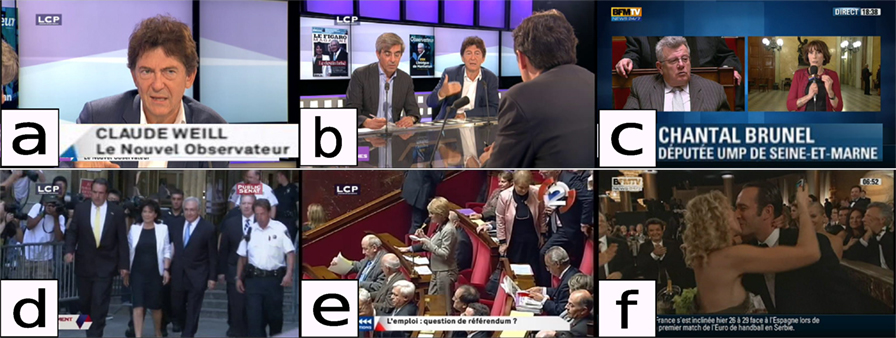
Figure 1. Example frames from the REPERE corpus showing the variety of the visual conditions (pose, camera viewpoint, and illumination) and the name-face association challenges, such as multiface images [image (C)] and name propagation [from (A,B)]. Images (A,C) show examples of OPNs. Corpus comprises debates [images (A,B)], information shows with complex editing [images (C,D)], parliamentary sessions [image (E), and celebrity news [image (F)].
In this paper, we assume that closed captions are not available as this is the case in European media. Instead, we focus on overlaid person names (OPNs), which are used to introduce the speakers, as illustrated in Figure 1A. Such names are appealing since their extraction is much more reliable than pronounced names obtained through automatic speech recognition (ASR). Moreover, their association with face or speech segments is in general easier than analyzing whether pronounced names in ASR transcripts refer to people appearing in the video. The identification systems submitted at the recent REPERE campaign (Bredin et al., 2013; Bechet et al., 2014; Poignant et al., 2014) mainly rely on such names.
Our approach offers several advantages. Faces are identified by alternating between a clustering step of faces and audio speech segments and a naming step of the resulting AV clusters. Each step is performed by a dedicated CRF. The use of CRF enables us to include heterogeneous context cues in our modeling. The use of such cues is challenging because they must use as little specific prior information as possible in order to achieve generalization over the different types of videos. In this paper, we include different generic context cues. First, we have AV association scores which enable to associate overlapping speaker and face segments when they correspond to the same person. Then, we use uniqueness constraints between simultaneously appearing pairs of faces. Furthermore, one of the main contributions is a background recurrence descriptor, which attributes a soft role to each segment. It enables to distinguish the persons who are announced by the OPNs, such as guests or journalists, from the anonymous persons appearing around them. Last but not least, the names contained in the OPNs are included to guide the clustering by using the probabilities obtained with the naming CRF. These different cues enable to improve the clustering by reducing errors due to monomodal-intracluster variations, such as facial pose or audio background noise. Eventually, the CRF formulation avoids hard local decisions by providing a joint probability distribution over all the segments.
The first CRF performs, jointly, the clustering of face tracks and speaker segments, thanks to AV association as introduced in Gay et al. (2014c). In practice, AV association is initialized in a pre-processing step based on temporal co-occurrence and then refined inside the CRF, thanks to talking-head detection scores and the previously described contextual cues. The second CRF assigns a name to each cluster by using co-occurrence statistics and a uniqueness constraint preventing any two faces on the same image to receive the same name. In Gay et al. (2014b), this approach was designed for face identification. In the present case, we extend this approach for the AV case and provide results for the final evaluation of the REPERE campaign. Identification performances are discussed by investigating the algorithm behavior in different types of shows (reports, news, debates, and celebrity magazines) and the relations with the clustering quality.
The rest of the article is organized as follows: Section 2 reviews related work on unsupervised identification. Then, Section 3 presents the proposed CRF-based system. Experiments and results are presented in Section 4. Finally, Section 5 sums up our main findings and concludes the paper.
2. Related Work
As stated in the Introduction, unsupervised people identification must address the problems of local person/name association and propagation to the video parts where the names are absent. The association is conducted via the use of co-occurrence statistics between the names present in the document and the detected persons. The propagation can be seen as a clustering problem. Clustering methods can regularly benefit from new improvements in speaker and face representations. At the time of writing, the ivector approach is one of the most successful (Rouvier et al., 2013) for the speaker-diarization task. Regarding face representation, recent advances include encodings (Simonyan et al., 2013), metric learning (Bhattarai et al., 2014), and feature learning by deep convolutional neural networks (Schroff et al., 2015). However, most of the systems require explicit face alignment to obtain frontal views, which is not always feasible. The work published in Zhang et al. (2015) suggests that using only face representation is a great limitation when dealing with unconstrained views of persons. For this reason, we believe that investigation into context-assisted clustering is justified, especially for broadcast news videos, which exhibit a strong structure.
To identify the faces, most approaches try to solve the association and the propagation problems jointly. On one hand, co-occurrence statistics at cluster level are more discriminant and accurate than just describing a face locally with namedness features (such as face position or talking activity) to assess whether the detected name should be associated. On the other hand, name/face co-occurrences are used as a contextual cue to improve the face clustering process. These principles have been used intensively since the seminal works of Berg et al. (2004) and Everingham et al. (2006), which applied to two representative use-cases: captioned images, as exemplified by the Yahoo News! dataset and soap series with the buffy dataset. The first case study consists of news articles with images illustrating the subject. The initial approach described in Berg et al. (2004) is an EM clustering where the update of the model parameters takes into account the name/face co-occurrences. In this context, the work of Ozkan and Duygulu (2010) exploits the fact that a textual query enables to retrieve faces where the queried person holds the majority. The problem of finding those faces is posed as finding the densest component in a graph. This idea was later extended in Guillaumin et al. (2010) where the distance within clusters is minimized with respect to a cannot-link constraint, which implies that two faces must belong to different clusters if their captions contain different names. However, those co-occurrence statistics can fail when group of people co-occur in a similar fashion, a situation commonly encountered in TV programs. In soap series, the names of the speakers can be obtained with the transcripts and the subtitles. Works in Cour et al. (2011), Wohlhart et al. (2011), and Bauml et al. (2013) use those names as weak labels to improve supervised classifiers. They choose a learning setting that takes into account the label ambiguities, for example, multiple instance learning (Wohlhart et al., 2011) and semi-supervised strategies (Bauml et al., 2013). Talking-head detection (Everingham et al., 2006; Cour et al., 2011) and dialog cues (Cour et al., 2010) are also used to solve the ambiguities in the face/name association. Note that in the previous two case studies, the naming co-occurrence statistics are quite different to those in broadcast videos, where the OPNs are more sporadic. Indeed, the OPN of a given person only appears one or a few times (usually for the first time utterance). This scarcity increases the dependence of the identification performance on the clustering quality.
Originally, unsupervised speaker identification in broadcast news was conducted by first performing a speaker diarization (i.e., clustering) step of the audio track and then assigning the names extracted from the transcription to the speaker clusters by using semantic classification trees (Jousse et al., 2009) or maximum-entropy classifiers (Ma et al., 2007). More recently, the idea of constrained speaker clustering has been exploited in Bredin and Poignant (2013) and Poignant et al. (2014). The system described in Bredin and Poignant (2013) defines a graph where the nodes are speaker segments and OPNs. OPNs are used to express must-link and cannot-link constraints between the utterances. The clustering and the naming of those segments are done using an Integer Linear Programming formulation. As first investigated by Li et al. (2001), the case study of videos allows to exploit the complementarity of audio and video modalities. AV cues, such as talking-head detection scores, can be used to match faces and speakers and to improve the monomodal speaker and face diarizations. The scores of such cues are computed by estimating motion in the region of the lips. In addition, features, such as the face size, the face position, or the number of faces in the image, are extracted and given to a supervised classifier (El Khoury et al., 2012; Vallet et al., 2013) to further refine the talking assessment. In order to bring corrections to the initial monomodal diarizations, the talking-head detection scores should be reliable where monomodal errors are present. Moreover, the audio and video will also be more complementary if they make errors at different moments. In other words, the improvements of the AV diarization depend on the performances of the initial monomodal ones. The work of Noulas et al. (2012) integrates faces and speech segments in a factorial hidden Markov model. The assignment of a segment to a cluster label is based on biometric model and on AV links with co-occurring segments from the other modality. The use of a graphical model enables to express dependences between variables with a global probabilistic formulation, which can then be optimized jointly. In order to jointly identify faces and speakers, the authors of Poignant et al. (2015) proposed a constrained multimodal clustering. They use the simple idea that two segments, which co-occur with different names, imply that they should be assigned to different clusters. The authors also showed that their multimodal clustering of faces and speakers can make use of talking-head detection scores to correct errors present in the monomodal systems.
The work of Bechet et al. (2014), an interesting yet not detailed contribution to the field, reports the intensive use of multimodal scene understanding cues. First, speaker diarization is performed and speakers are identified using OPNs or pre-trained models. Then, identities are propagated from the speakers to the faces. Scene segmentation, role detection, and pre-trained visual models for each TV set (and sometimes for each camera) are used to indicate how many faces are present on screen and what their roles are. Such a fine-grain modeling enables them to report the best identification on the REPERE campaign. Indeed, it permits to tell which persons are present without detecting the faces by detecting the specific shot (up to which studio camera is used). Thus, profile views and persons seen from the back can be identified. However, to learn those models, manual annotations have been made for each show. This poses the problem of human labor cost and lack of generalization. More generally, several researchers focus on exploiting the context surrounding the faces. The work in Zhang et al. (2013) uses clothes, image background, cluster co-occurrences, and attribute classifiers as context, while Tapaswi et al. (2014) build must-link and cannot-link constraints deduced from shot threads (sequence of shots obtained from the same camera angle).
2.1. Contributions
In this paper, we leverage on different contextual cues present in the state-of-the-art, introduce new ones, and include them in our CRF model. First, instead of conducting speaker and face clustering separately (Bhattarai et al., 2014; Gay et al., 2014a), we perform a joint clustering of face tracks and speaker segments, which also benefits from the OPNs information. To be more precise, we compute local face visual backgrounds (LFBs) around each face track and cluster them. This provides us with a signature for each face track characterizing the level of recurrence of its LFB in the data. Intuitively, a recurrent LFB correspond to people who are important and can be seen as a soft role assignment distinguishing faces to be named from faces of figurative people. Concretely, it enables to encourage faces tracks with recurrent LFBs to join named clusters, i.e., overlapping an OPN. Second, a naming CRF performs the joint identification of all person clusters, thus accounting for uniqueness constraints and co-occurrence statistics between clusters and OPNs. Unlike previous works which rely on extensive annotations (Bechet et al., 2014), those elements of context have better generalization capabilities, since we can learn one single model over a large and diversified corpus, and require less annotations if we want to learn a new type of show. Thanks to the flexibility of the CRF formulation, new contextual cues could be added in the future to further improve the performances.
3. Method
The method will be first described globally in Section 3.1. In Section 3.2, we introduce the notations. We then describe how we extract LFB and AV association features in Sections 3.3 and 3.4. In Section 3.5, the diarization CRF, which clusters face and speech segments is presented, and in Section 3.6 the naming CRF, which is in charge of identifying the clusters. To conclude this part, we describe how the full system is used and optimized in Section 3.7.
3.1. Method Overview
The general approach is summarized in Figure 2. First, the different modalities are processed separately: monomodal speaker (Rouvier et al., 2013) and face (Khoury et al., 2013) diarizations are performed, LFBs are extracted around each face and clustered, optical character recognition (OCR) is performed to extract the overlaid texts (Chen and Odobez, 2005), and named entities are detected (Gay et al., 2014a).
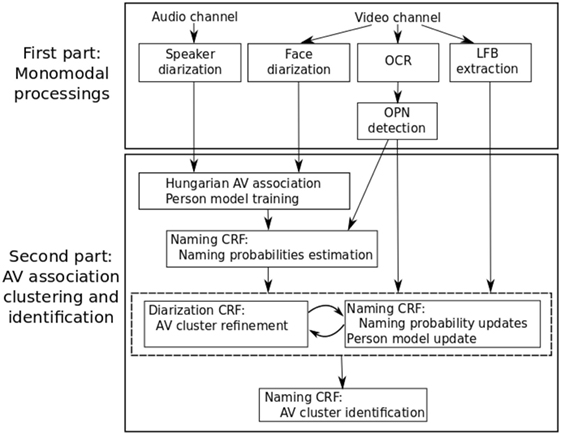
Figure 2. Overview of the system. First, face tracks and speech utterances are detected and clustered separately. They are then used with the OPNs in an iterative combination of the two CRFs. The first one to refine the diarization and the other one to identify the clusters. The latter is eventually used for the final cluster identification.
In the second part, we perform the AV clustering and the naming of the persons. Initially, we use the Hungarian algorithm to associate face and speaker clusters based on their temporal overlap. Naming probabilities are then computed onto those AV clusters with the naming CRF. Lastly, the system iterates over a clustering step and a naming step. In the clustering step, the diarization CRF infers a cluster label for each face track and utterance given the naming probabilities, an acoustic and visual person model for each cluster label, and various context clues including the LFBs. In the naming step, person models and naming probabilities are updated as a result of the new diarization. The motivation factor being that the diarization CRF is able to use contextual clues to correct potential clustering errors made by the monomodal diarizations and thus improves the final identification. Lastly, a name is associated with each cluster with the naming CRF.
3.2. Notations
The pre-processing includes obtaining initial monomodal face and speaker clusters, a set of OPNs and extracting the features from those elements. First, faces are detected (Viola and Jones, 2004) and tracked within each shot, resulting in a set of face tracks denoted as V = {Vi, i = 1, …, NV}. Each face track Vi is characterized by a set of visual features [set of speeded-up-robust features (SURF) extracted in up to 9 images of the face track (El Khoury et al., 2010)] and a set of Boolean features indicating whether Vi corresponds to a recurrent LFB as explained in the next Section 3.3.
Second, OCR (Chen and Odobez, 2005) and named entity detection techniques based on string matching against external resources (predefined lists, freebase database, Google hits, etc.) are applied as described in Gay et al. (2014a) to extract the set O = {Oi, i = 1, …, NO} of OPNs. Each OPN Oi is characterized by its duration and its name , where M = {nj, j = 1, …, NM} denotes the set of unique names extracted from the video.
Finally, the audio stream is segmented into a set A = {Ai, i = 1, …, NA} of continuous speech segments called utterances, each described by a set of acoustic features . Features are 12 MFCCs with first order derivatives. Each frame is normalized with a short-term windowed mean and variance. Feature warping is also applied. In addition, a set of Boolean features is extracted indicating whether Ai is co-occurring with a recurrent LFB, as described in the next section. Finally, talking-head detection features are extracted between each couple (Ai, Vj) with a non-zero overlap as described in Section 3.4.
3.3. Local Face Background Recurrence
We want to capture whether a face appears with a recurrent visual background. This feature will be included in the diarization CRF. To this end, we focus on an area around each face track Vi to capture the background context of this face. We do not consider full images as the same image might include different face visual contexts (see the first, fourth, and fifth images from the left in the top row of Figure 4). Instead, we select a rectangle area around each face as local face background (LFB) representative by following a predefined spatial template between the face and this rectangle as can be seen in Figure 3. In practice, the fixed proportions were chosen manually so as to avoid a potential overlap with other parts of the images in typical edited videos like in the 4th and 5th images from the left on the top of Figure 4. We then characterize each obtained rectangle area with SURF features and, in order to cluster them, we use a hierarchical clustering approach (El Khoury et al., 2010). Then, we set to true if face track Vi belongs to a local background cluster whose number of elements is higher than k. In practice, multiple values of k can be used to characterize different levels of recurrence and reduce the importance of the stopping criterion of the hierarchical clustering. Figure 4 shows examples of obtained recurrent and non-recurrent patterns.
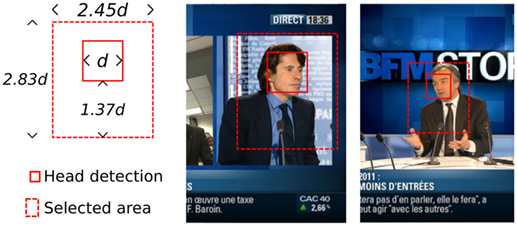
Figure 3. Left: predefined spatial template for the background face selection area given a head detection. Center and right: two examples with head detections and the selected background areas.
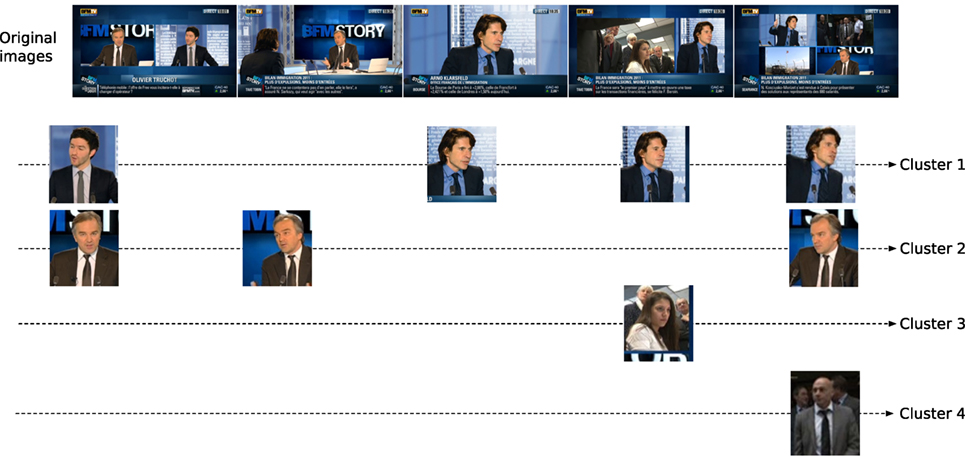
Figure 4. Top: original images. Bottom: clusters of recurrent local face backgrounds (LFB) automatically cropped from each image and clustered given the localized faces. Each row corresponds to a local background cluster. Clusters 1 and 2 are recurrent backgrounds and correspond to speakers. Clusters 3 and 4 are not recurrent. They contain non-speaking faces, which appear occasionally in the video.
3.4. Talking-Head Detection Features
In order to integrate AV association information in the CRF, we detect talking heads. To characterize talking heads, we use the following measures. These features are extracted for each overlapping utterance/face track couple and include
• Lip activity: the lip activity of a given face at frame k is computed as described in El Khoury et al. (2012) and consists in the mean intensity difference between frame k and k + 1 after local image registration in predefined regions corresponding to the lips. In addition, we focus on the relative lip activity by dividing by the sum of all the lip activities measured from all people in the image.
• Head size: the interest of this feature relies on the hypothesis that the face of the speaker is usually larger than the faces of other people in the image. Put simply, we take the diagonal size of the detection bounding boxes. We also use the relative head size.
The previous features are computed from each frame of the face track. Eventually, the final feature is an average over all values from the frames included in the overlap between the utterance Ai and the face track Vj. This corresponds to the method used in Gay et al. (2014c). To assess whether a couple of utterance/face track corresponds to a talking head given the features, we use an SVM with Gaussian kernel denoted as h.
3.5. Audiovisual Person Diarization CRF
The clustering of face tracks and utterances defines itself by estimating the label field as such, the same person index is used for and when the utterance Ai and the face track Vj correspond to the same person. The labels and take value in the set of possible person indices denoted as P. To achieve this, let G be an undirected graph over the set of random variables A, V, O, and Ed. We then seek to maximize the CRF posterior probability formulated as:
where each triplet (fi, Gi, λi) is composed of a feature function fi, a weight λi learned at training time, and the set Gi of cliques where this function is defined. (Ac, Vc, Oc, Ec) denotes the set of nodes contained in the clique c. F is a set of abstract functions indices. We use 6 types of feature functions which will be described in the next sections. A graphical representation of this model is illustrated in Figure 5.
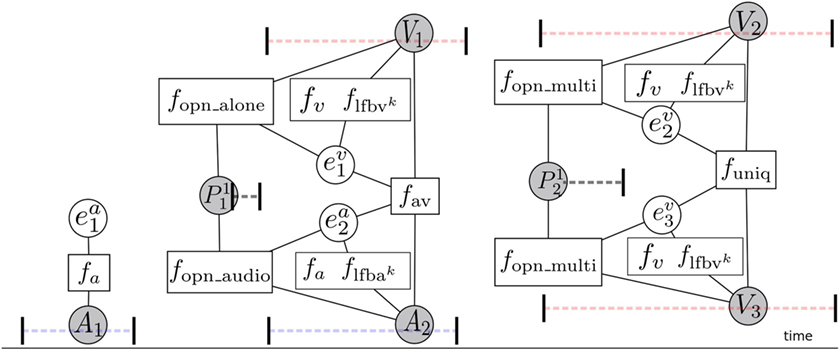
Figure 5. Factor graph illustrating the diarization CRF using talking-head information (fav) and the context from the OPNs (fopn, flfb). The blank circle nodes correspond to hidden variables, the shaded circle nodes correspond to observations, while the squares represent the feature functions. The x-axis represents time and the drawing shows also segments corresponding to the time intervals during which a specific observation (track, utterance, and OPN) occurs. Red dot segments illustrate the face track temporal segments, while blue plain segments the utterances.
3.5.1. The Association Function
The association function fav favors the association of talking heads to utterances. The function is defined on all overlapping utterance/face track couples {(i, j)/t (Ai, Vj) ≠ 0} where t(Ai, Vj) is the overlapping time duration between segments Ai and Vj:
where represents the binary output of the SVM classifier introduced in Section 3.4. It corresponds to 1 when the face and the speaker correspond to the same person and −1 otherwise. We chose a SVM classifier since it shows good results in El Khoury et al. (2012) and Vallet et al. (2013). Other techniques could be employed, but we leave this problem for future research.
3.5.2. The Visual Feature Function
The visual feature function , defined for all face tracks Vi ∈ V, indicates how likely the visual features of Vi should be labeled with the person index . This is a face modeling task in which for each label ei, we need to define a visual model that is learned from the data currently associated with the label. Practically, fv computes as score between Vi and a label the 10th percentile SURF vector distances between and all the SURF features of the current face tracks associated with this label. The distance between two face tracks is computed following El Khoury et al. (2010). Although the use of SURF features could be discussed regarding other more modern representations, we observe that their matching power is useful for similar faces of the same person viewed from a similar view point. The previous work in Gay et al. (2014b) uses an average of the distances. By using the percentile, we found a slight improvement for the diarization task (0.2 points on the development REPERE corpus). We believe that the use of a percentile instead of averaging enables to merge 2 clusters of the same identity but containing samples whose poses are dominantly from different poses.
3.5.3. The Acoustic Function
The acoustic function , defined over all utterances Ai ∈ A, is the audio equivalent of fv. We chose a 512 GMM-UBM with diagonal covariance following Ben et al. (2004). We did not use iVectors since we might need to learn a model on small clusters containing only a few seconds of speech. computes the likelihood score of the features given the GMM model learned over the data currently associated with the cluster label .
3.5.4. The LFB Feature Function
The LFB feature function is driven by the assumption that faces inside a recurrent LFB are likely to correspond to a speaker announced by an OPN. To favor face tracks identified as recurrent LFB to join a person cluster which could be named, we define the following feature function. For each face track Vi,
where opn is the set of person clusters indices co-occurring with an OPN, i.e., the set of clusters which are currently associated with a name.
This principle is extended to each utterance Ai with the function , which employs the feature . To this end, we assume that the utterances co-occurring with a recurrent LFB should be assigned a cluster label from the set opn. Thus, as discussed in Section 3.3, is set to true if utterance Ai is overlapping with a face track Vj such that is true. We then introduce the same function as in the video case:
Interestingly, these functions act as a namedness feature (Pham et al., 2008) in the sense that they favor the naming of the corresponding face tracks and utterances. They also softly constrain the number of clusters. In other words, the clusters whose labels belong to opn will attract the segments identified as recurrent LFB. Note that if the constraint was strictly enforced, each concerned audio or visual segment would only be assigned to a member of opn.
3.5.5. The OPN Feature Functions
The OPN feature functions bring a special treatment to the segments co-occurring with OPNs. The idea is to favor segments (face tracks or utterances) co-occurring with an OPN Oj to be assigned to a person cluster likely to be labeled with the name . Thus, we define:
where is the probability that the name contained in the OPN, Oj corresponds to the cluster label given the clustering C and the set of OPNs P. Here, we denote as the naming label of cluster label . This probability is computed with the naming CRF as defined in Section 3.6.
Similarly, we use fopn_multi if Vi co-occurs with other faces:
We also define fopn_audio for each co-occurring couple (Ai, Oj):
Differentiating these 3 cases enables to learn specific λ weights so that the model behavior is adapted to each situation.
3.5.6. The Uniqueness Feature Function
The uniqueness feature function ensures two faces that co-occur in the same shot to have different labels (Berg et al., 2004; Pham et al., 2013). For such a pair Vi, Vj:
It is crucial to use this function because due to the OPN feature functions, multiple faces co-occurring with the same OPN will tend to be assigned to the same person cluster.
3.6. Cluster Identification
The previous diarization CRF provides us a set of AV person clusters C = {Ci, i = 1, …, NC}. Thus, in the naming step, the goal incorporates estimating the label field such that the label corresponds to the name of the cluster Ci. The label takes value in the set of names M augmented by an anonymous label, which should be assigned to anonymous persons. For this naming CRF, the posterior probability uses 6 feature functions:
Figure 6 represents an illustration of this. This naming model exploits four different co-occurrence statistics between clusters and OPNs. The first function falone is defined over each triplet (, Ci, Oj) where the OPN Oj must co-occur with a face track which belongs to Ci and which is alone in the image. Let us denote as δ(Ci, Oj) the co-occurring time between the face tracks which occurs alone in the cluster Ci and Oj. Then, we have
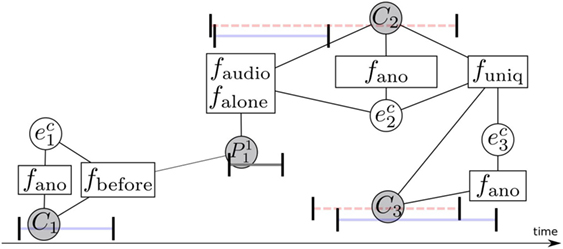
Figure 6. Factor graph illustrating the naming CRF using the co-occurrence functions with the OPNs and the uniqueness constraint. The conventions are the same as in Figure 5.
As for the OPN diarization model components, we define similarly two other functions fmulti and faudio that measure the overlapping time between Oj and the face tracks of Ci, which occur with other faces, on one hand, and with the audio segments of Ci, on the other hand. Moreover, we exploit the assumption that a person does not usually appear or speak before the first apparition of his name in an OPN to define fbefore (, Ci, Oj), which returns the number of audio segments from cluster Ci that occur before the first apparition of the name associated with the OPN Oj.
We also introduce prior knowledge over the anonymous label by defining a fifth feature function fano (,Ci), which returns 1 if is the anonymous label. When applied, it allows the model to penalize the fact of not identifying a person and improves the recall.
Lastly, we define a uniqueness function funiq (,Ci, ,Cj) over visually overlapping clusters just as in the diarization step. For each cluster pair (Ci, Cj) with overlapping face tracks:
3.7. Optimization
The joint use of the two CRFs is conducted by applying the following steps: (i) the diarization labels are firstly initialized by separately performing audio and video clustering and then associating the clusters to obtain the potential AV person labels P (audio and face cluster couples). The association is conducted using the Hungarian algorithm (Kuhn, 1955) where the cost for a cluster couple is defined as the sum of the scores from the function fav over all its utterance/face track pairs. (ii) For each resulting person label pi, biometric models are learned from their associated data and naming probabilities for each label are estimated by using the naming CRF. (iii) Given these models, we run the loopy belief propagation inference to get the most probable diarization labels Ed by solving .
Eventually, Steps (ii) and (iii) are iterated in an expectation–maximization style by alternating model updates and inference. Ideally, one would iterate until convergence, i.e., when the label for each segment becomes stable. In practice, as there is no guarantee that the algorithm converges, a fixed number of iterations is tuned over the development set since we observe only small modifications after a few iterations.
The computational bottleneck with the loopy belief propagation algorithm occurs in the presence of big cliques. This is the case, in our graphs, when the uniqueness constraint is applied to images where there are more than 20 faces. In such cases, uniqueness constraints can be dropped from the graph during inference and enforced in a post-processing step.
4. Results and Discussion
This section will first present our experimental setup: the corpus (Section 4.1), implementation details (Section 4.2), and the metrics used for the evaluation (Section 4.3). Then, in Section 4.4, we present our results showing identification and clustering performances in function of the different parts of the model.
4.1. Corpus Description
We used the REPERE corpus (Giraudel et al., 2012) for our experiments. It involves broadcast data videos containing 4 main types of shows (i) debates in indoor studio (Figures 1A,B), (ii) modern format information shows which contain reports and interviews with dynamic picture compositions (Figures 1C,D), (iii) extracts from parliamentary sessions “Questions to the government” (Figure 1E), and (iv) celebrity news (Figure 1F).
We evaluate our approach on the final test set which contains 37 h during which 10 are annotated. A development set is used to optimize the number of LFB functions and the number of iterations between the two CRFs. It consists of 28 h among which 6 are annotated. The SVM h used in the fav feature function and the CRF parameters are learned on the test set of the first REPERE evaluation that is composed of 3 h of annotated data.
4.2. Parameter Settings and Algorithm Details
We set the K value to 3, 4, and 5 for the LFB feature functions. We set the number of iterations between the two CRFs to 3 as we noticed that no major changes usually occur after that point. It is important to note that these CRF parameters are learned on automatic detections and automatic clusters and not on cleanly segmented ones. Therefore, it enables us to take into account the noise present at test time. We use the GRMM toolbox (McCallum, 2002) for the CRF implementation.
The initial speaker diarization system is the LiumSpkDiarization toolbox (http://www-lium.univ-lemans.fr/diarization), which combines iVector representation and ILP clustering (Rouvier et al., 2013). It has achieved state-of-the-art results in several speaker diarization benchmarks (Rouvier and Meignier, 2012). The initial face diarization uses the system described in Khoury et al. (2013), which combines SURF based distances and DCT features whose distribution is modeled with GMMs. This system has been evaluated on the public Buffy dataset (Cinbis et al., 2011) and compares favorably to other metric learning methods. The use of state-of-the-art systems enables us to verify that our CRF is able to correct errors, which are proven difficult to solve in the monomodal case.
4.3. Performance Measures
The overall identification performance is measured with the estimated global error rate (EGER), which is the REPERE evaluation metric. It is defined as follows:
where ♯ conf is the number of wrongly identified persons, ♯ miss, the number of missed persons, ♯ false, the number of false alarms, and (total, the total number of persons to be detected. It should be noted that the metric ignores the spatial position of the faces and simply uses a person list for each annotated image. The behavior of this metric is illustrated in Figure 7. Wrong predictions are counted as false alarms only if the number of predictions exceeds the number of persons in the annotation. Otherwise, they are counted as confusions. Similarly, missing persons are reported only if the number of predictions is smaller than the number of persons.

Figure 7. Extract of an evaluation file for face identification. The second row is the reference name list and the third row is the predicted list. Augusta_ADA_KING will be counted as correct. One of the two remaining names will be counted as confusion with Barack_OBAMA, and the third one will be a false alarm. Since there are 2 persons in the reference and the system made 2 errors, the corresponding EGER of this example is 1.
We also use the clustering error rate (CER) to study the correlation between clustering and identification performances as our work is motivated by an interdependence between those two tasks. Initially, the CER has been introduced for the speaker clustering task (NIST, 2003) and is defined as
where the audio file is divided in continuous segments at each speaker change and
• dur(seg) is the duration of the segment seg.
• NRef(seg) is the number of active speakers during segment seg.
• NSys(seg) is the number of speakers detected by the system.
• NCorrect(seg) is the number of speakers correctly detected by the system. A match needs to be made between the clusters and the speaker references in order to compute this term.
We applied this measure to the face clustering task. With the audio CER, a detected speech segment is matched to a reference during their temporal overlap. The only modification to tackle visual modality is that face detection must have a temporal and spatial overlap to be matched with a reference. In addition, note that we do not consider false alarms and missed detections that are usually considered in NIST to compare the effects of the different systems since the only error that changes with methods given the setup (fixed face tracks and utterances) is due to the final clustering of the face and speech segments. Thus, miss detections and false alarms are identical.
4.4. Identification and Clustering Results with the CRF Combination
4.4.1. Diarization Results
We first describe the diarization results presented in Table 1. We can see that the full CRF model has a slightly lower error rate over the whole corpus than the initial monomodal systems (6.8 vs. 7.4% for the speakers and 5.0 vs. 5.2% for the faces). On the other hand, the performances depend strongly on the type of shows. For instance, an important part of the global improvement comes from the debate videos (4.0 vs. 6.6% for the speakers and 1.9 vs. 4.9% for the faces). In debates, most of the scenes are in the same studio, thereby reducing the visual variability of the background image, and most of the persons present are speakers announced by an OPN. Thus, most faces and utterances are featured as recurrent (i.e., is set to true), and the flfb functions have a positive impact on the diarization. They enable to solve clustering confusion errors by constraining the number of clusters toward the number of detected OPNs. Indeed, if we remove the n related functions flfb and fopn (cf. third column of Table 1), most of the improvements are lost. It appears that the use of multimodality does not help to correct clustering errors. This is somewhat surprising as past works (Gay et al., 2014c) reports improvements in the audio modality with this very system on the same type of data. The difference with this previous work is that our initial monomodal speaker diarization system has become much more efficient, essentially thanks to a careful selection of the data used to train the generic speaker model UBM. This way, there are much fewer errors to correct.
In the case of celebrity magazines, the diarization CRF increases the error rate (15.1 vs. 14.6% for the speakers and 7.9 vs. 3.5% for the faces). Those videos contain very few OPNs and essentially short outdoor scenes. Thus, the flfb functions cannot help the CRF to take appropriate decisions. Moreover, previous experiments reported in Gay et al. (2014c) showed that the use of the biometric person models inside the CRF framework appears to be less efficient than when it is used in the hierarchical monomodal systems.
The importance of the OPN-related functions is also visible if we consider the λ parameters learned by the CRF in Table 2. During training, the weight λav are indeed set to a relatively low value as compared to the other terms (although those values are ponderated by the amplitude of the feature functions). We have found that for a majority of segments, the flfb function is dominant. This is further illustrated in Table 4.
4.4.2. Identification Results
We now turn to the identification results reported in Table 3. We compare 3 systems: we denote by N the naming CRF applied on top of the initial monomodal diarizations described in Khoury et al. (2013) and Rouvier et al. (2013), N + D is the joint use of the naming and the diarization CRF, and the last one is an oracle. Note that the oracle still produces errors, since, as we deal with automatic face detection and tracking, there are errors that a perfect clustering and naming cannot correct: false alarms, missed faces, and face tracks for which the identity is not introduced by an OPN (see more about this in Figure 8). Adding the diarization CRF permits to globally reduce the error rates in both modalities (31.4 vs. 33.4% for the speakers and 52.2 vs. 54.5% for the faces), especially for debate and parliament videos. This is not surprising as we previously showed that the diarization CRF have less confusion errors for studio scenes than the initial monomodal systems.
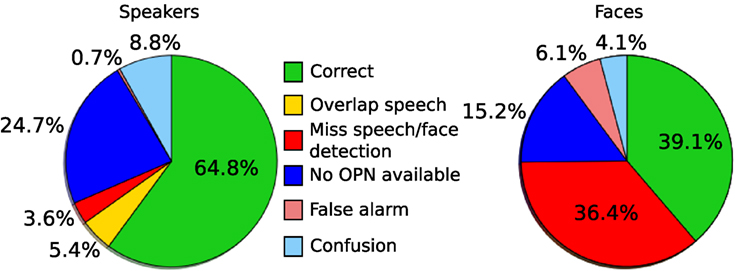
Figure 8. Different errors for the speaker (left) and face (right) identification tasks. Percentages are expressed relatively to the number of annotations.
Regarding news videos, although we saw that clustering confusion errors were not reduced globally, the use of the diarization CRF also improves the identification. This is probably due to the correction of confusion errors in studio scenes, which have a greater impact on the identification than errors concerning anonymous persons in reports.
The structure of celebrity magazines differs from the other shows as it contains very few OPNs and recurrent LFB. In those cases, the diarization CRF degrades both diarization and identification performances. We design an oracle on the diarization and the identification to measure the potential improvements. It uses automatic face/speech segment detections and automatic OPN extraction. Then, the association between these segments and the OPNs is done with the manual reference. Thus, the errors made by the oracle correspond to missing OPNs or missing segment detections. In the case of celebrity shows, with an error rate of 75.3%, the OPN-based approach is clearly not suitable.
4.4.3. Error Analysis
The proportion of the different error types can be visualized globally on the pie charts in Figure 8. Regarding the speaker identification task, the lack of OPNs explains most of the errors as 24.7% of the annotated persons are not announced, most of them being journalists. As for the faces, the detection step is more crucial as 36.4% of the persons’ faces are not detected. This corresponds usually to profile faces or persons seen from the back. Most of the false alarms are anonymous persons incorrectly identified.
We also illustrate the correlation between diarization and identification performances in Figure 9. We plot the performance differences for each video between the full system (N + D) and the CRF naming alone (N). We observe that they are unique to their type of show. The debate videos appear in the top-right part of the plane, which means that the diarization CRF improves the diarization and the identification. Concerning news and parliament videos, the correlation between CER and DER is not as strong as in the debate case. The presence of anonymous persons and off voices implies that a change in the diarization does not necessarily correspond to a change in identification performances.
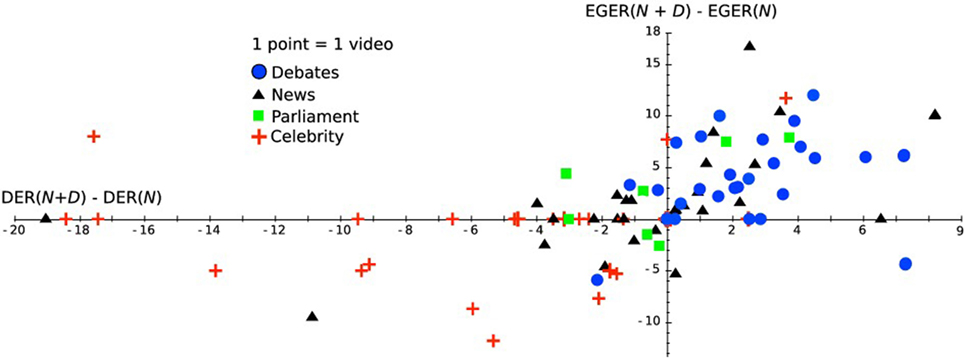
Figure 9. The Y-axis is the EGER difference between the CRF combination and the naming CRF alone measured for the faces. The X-axis is the DER difference between the diarization CRF and the initial monomodal face diarization (Khoury et al., 2013).
Finally, Table 4 shows the performance of the model when adding the different components of the diarization CRF one by one. If we focus on the first and second lines, we see that the CRF with only 3 feature functions degrades the performances compared to the monomodal diarizations. We find that, used alone, the monomodal representations present in the CRF (see the fa and fv functions) do not compare favorably with the monomodal diarization frameworks. This could be improved in a future work by using better person representations. However, each other component enables to reduce the error rate and the full model provides the best performances. It should also be noticed that, although it might generates big cliques in some cases, the uniqueness function is essential to benefit from the fopn feature functions. If not applied, an OPN will be propagated to all the faces overlapping with him.
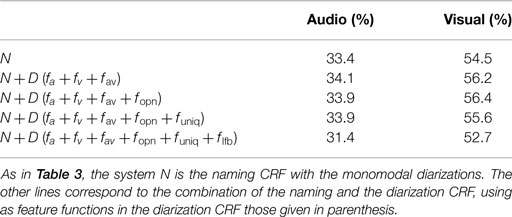
Table 4. Contribution of the different diarization model components on the naming task (results in EGER).
4.4.4. Comparison with State-of-the-Art and Discussion
On the same dataset, the system described in Bechet et al. (2014) obtains an EGER of 30.9% for the speakers and 39.4% for the faces. Thus, it proves to have a better performance especially regarding the faces. This is possible with the help of pre-trained models for each show, which enable to indicate how many faces should be present on screen and what their roles are. For instance, when it detects the configuration shown in Figure 1C, it deduces that the announced guest is present on the right even if no faces have been detected. In fact, this approach does not even use a face diarization module. However, it requires a large amount of learning and a priori information. By comparison, our method is much simpler to implement, especially since it has better generalization capabilities, we learn one single model over a large and diverse corpus, and what is more, it requires less annotations if we need to process a new type of show.
The constrained hierarchical clustering detailed in Poignant et al. (2015) obtains an EGER of 35.9% for the speakers and 44.3% for the faces. Compared with our system, it has better performances on the faces, but worst for the speakers. As we do, they only rely on OPNs without other specific supervised information on the show. According to their paper, it seems that their constrained multimodal clustering that avoids clustering together faces, which co-occur with different OPN names, is one of the contributions which improves results and that we do not use, and could explain the difference. Nevertheless, the influence of each pre-processing (speaker and face detections, monomodal clusterings, and OPN detection) makes it hard to analyze the performance difference.
5. Conclusion
In this paper, we presented our contribution for AV person diarization and identification from OPNs. Our system uses an iterative combination of 2 CRFs: one performing the AV diarization at a person level and the second one associating the names and the clusters. Several context modeling cues are used to solve the person/name association problem and the diarization issues. While it is clear that more supervised learning and a priori information on the context can improve the performances, our approach provides an interesting trade-off between performance on one hand and generalization/low annotation cost on the other hand. The principal contextual cue consists in the face image background. It allows us to distinguish the faces and the speakers which are announced by OPNs and guide the clustering accordingly.
In this work, we did not address the issue of non-frontal face detection. As a short-term perspective, it would be interesting to increase the recall of the face detector, for instance, by adding a profile view detector. This would render the face clustering task more challenging and the potential benefit from context modeling would be greater. Second, our context modeling assumes that speakers are announced by an OPN the first time they talk. For the REPERE dataset, this is the case. However, this assumption could be sensible to broadcaster’s editing policies. Actually, the optimal choice of the context for unsupervised person identification is a difficult problem if we want to avoid the need for specific annotations for each show. One solution to consider is to learn the setting of each show or a part of the setting from a corpus in an unsupervised way.
Author Contributions
All authors made equal contribution in this work.
Conflict of Interest Statement
The authors declare that the research was conducted in the absence of any commercial or financial relationships that could be construed as a potential conflict of interest.
Funding
The authors gratefully acknowledge the financial support from the French Research Agency (ANR) under the Project SODA and from the European Union under the EUMSSI project (grant agreement 611057).
References
Bauml, M., Tapaswi, M., and Stiefelhagen, R. (2013). “Semi-supervised learning with constraints for person identification in multimedia data,” in Proceedings of the IEEE Conference on Computer Vision and Pattern Recognition (Portland: IEEE), 3602–3609.
Bechet, F., Bendris, M., Charlet, D., Damnati, G., Favre, B., Rouvier, M., et al. (2014). “Multimodal understanding for person recognition in video broadcasts,” in Proceedings of Interspeech (Singapore: ISCA), 146–151.
Ben, M., Betser, M., Bimbot, F., and Gravier, G. (2004). “Speaker diarization using bottom-up clustering based on a parameter-derived distance between adapted GMMs,” in Proceedings of International Conference on Spoken Language Processing (Jeju: ISCA), 523–538.
Berg, T. L., Berg, A. C., Edwards, J., Maire, M., White, R., Teh, Y. W., et al. (2004). “Names and faces in the news,” in Proceedings of the IEEE Conference on Computer Vision and Pattern Recognition, Vol. 2 (Washington: IEEE), 836–848.
Bhattarai, B., Sharma, G., Jurie, F., and Pérez, P. (2014). “Some faces are more equal than others: hierarchical organization for accurate and efficient large-scale identity-based face retrieval,” in Proceedings of the European Conference on Computer Vision (Zurich: Springer), 160–172.
Bredin, H., and Poignant, J. (2013). “Integer linear programming for speaker diarization and cross-modal identification in TV broadcast,” in Proceedings of InterSpeech (Lyon: ISCA), 49–54.
Bredin, H., Poignant, J., Tapaswi, M., Fortier, G., Le, V., Napoleon, T., et al. (2013). “QCompere@REPERE 2013,” in Workshop on Speech, Language and Audio in Multimedia (Marseille: ISCA), 49–54.
Chen, D., and Odobez, J.-M. (2005). Video text recognition using sequential Monte Carlo and error voting methods. Pattern Recognit. Lett. 26, 1386–1403. doi: 10.1016/j.patrec.2004.11.019
Cinbis, R. G., Verbeek, J., and Schmid, C. (2011). “Unsupervised metric learning for face identification in TV video,” in Proceedings of the IEEE International Conference on Computer Vision (Barcelona: IEEE), 1559–1566.
Cour, T., Sapp, B., Nagle, A., and Taskar, B. (2010). “Talking pictures: temporal grouping and dialog-supervised person recognition,” in Proceedings of the IEEE Conference on Computer Vision and Pattern Recognition (San Francisco: IEEE), 1014–1021.
Cour, T., Sapp, B., and Taskar, B. (2011). Learning from partial labels. J. Mach. Learn. Res. 12, 1501–1536. doi:10.1109/cvpr.2010.5540106
El Khoury, E., Senac, C., and Joly, P. (2010). “Face-and-clothing based people clustering in video content,” in Proceedings of the International Conference on Multimedia Information Retrieval (Philadelphia: ACM), 295–304.
El Khoury, E., Sénac, C., and Joly, P. (2012). Audiovisual diarization of people in video content. Multimed. Tools Appl. 68, 747–775. doi:10.1007/s11042-012-1080-6
Everingham, M., Sivic, J., and Zisserman, A. (2006). “Hello! my name is… Buffy – automatic naming of characters in TV video,” in Proceedings of the British Machine Vision Conference, Vol. 2 (Edinburgh: BMVA), 2365–2371.
Gay, P., Dupuy, G., Lailler, C., Odobez, J.-M., Meignier, S., and Deléglise, P. (2014a). “Comparison of two methods for unsupervised person identification in TV shows,” in Proceedings of the Content Based Multimedia Indexing Workshop (Klagenfurt: IEEE), 1–6.
Gay, P., Elie, K., Sylvain, M., Jean-Marc, O., and Paul, D. (2014b). “A conditional random field approach for face identification in broadcast news using overlaid text,” in Proceedings of the IEEE International Conference on Image Processing (Paris: IEEE), 318–322.
Gay, P., Khoury, E., Meignier, S., Odobez, J.-M., and Deleglise, P. (2014c). “A conditional random field approach for audio-visual people diarization,” in Proceedings of the IEEE International Conference on Acoustics, Speech and Signal Processing (Florence: IEEE), 116–120.
Giraudel, A., Carré, M., Mapelli, V., Kahn, J., Galibert, O., and Quintard, L. (2012). “The REPERE corpus: a multimodal corpus for person recognition,” in Proceedings of the International Conference on Language Resources and Evaluation (Istanbul: ELRA), 1102–1107.
Guillaumin, M., Verbeek, J., and Schmid, C. (2010). “Multiple instance metric learning from automatically labeled bags of faces,” in Proceedings of the European Conference on Computer Vision (Crete: Springer), 634–647.
Jou, B., Li, H., Ellis, J. G., Morozoff-Abegauz, D., and Chang, S. (2013). “Structured exploration of who, what, when, and where in heterogeneous multimedia news sources,” in Proceedings of ACM International Conference on Multimedia (Barcelona: ACM), 357–360.
Jousse, V., Petit-Renaud, S., Meignier, S., Esteve, Y., and Jacquin, C. (2009). “Automatic named identification of speakers using diarization and ASR systems,” in Proceedings of the IEEE International Conference on Acoustics, Speech and Signal Processing (Taipei: IEEE), 4557–4560.
El Khoury, E., Gay, P., and Odobez, J. (2013). “Fusing matching and biometric similarity measures for face diarization in video,” in Proceedings of the IEEE International Conference on Multimedia Retrieval (Dallas: IEEE), 97–104.
Kuhn, H. W. (1955). The Hungarian method for the assignment problem. Nav. Res. Logistics Q. 2, 83–97. doi:10.1002/nav.3800020109
Li, D., Wei, G., Sethi, I. K., and Dimitrova, N. (2001). Person identification in TV programs. J. Electron. Imaging 10, 930–938. doi:10.1117/1.1406947
Ma, C., Nguyen, P., and Mahajan, M. (2007). “Finding speaker identities with a conditional maximum entropy model,” in Proceedings of the IEEE International Conference on Acoustics, Speech and Signal Processing, Vol. 4 (Honolulu: IEEE), 253–261.
McCallum, A. K. (2002). MALLET: A Machine Learning for Language Toolkit. Available at: http://mallet.cs.umass.edu
Noulas, A., Englebienne, G., and Krose, B. J. (2012). Multimodal speaker diarization. IEEE Trans. Pattern Anal. Mach. Intell. 34, 79–93. doi:10.1109/TPAMI.2011.47
Ozkan, D., and Duygulu, P. (2010). Interesting faces: a graph-based approach for finding people in news. Pattern Recognit. 43, 1717–1735. doi:10.1016/j.patcog.2009.10.015
Pham, P., Moens, M.-F., and Tuytelaars, T. (2008). “Linking names and faces: seeing the problem in different ways,” in Proceedings of the European Conference on Computer Vision (Marseille: Springer), 68–81.
Pham, P. T., Deschacht, K., Tuytelaars, T., and Moens, M.-F. (2013). Naming persons in video: using the weak supervision of textual stories. J. Vis. Commun. Image R. 24, 944–955. doi:10.1016/j.jvcir.2013.06.009
Poignant, J., Besacier, L., and Quénot, G. (2014). Unsupervised speaker identification in TV broadcast based on written names. IEEE/ACM Trans. Audio Speech Lang. Process. 23, 57–68. doi:10.1109/taslp.2014.2367822
Poignant, J., Fortier, G., Besacier, L., and Quénot, G. (2015). Naming multi-modal clusters to identify persons in TV broadcast. Multimed. Tools Appl. 1, 1–25. doi:10.1007/s11042-015-2723-1
Rouvier, M., Dupuy, G., Gay, P., Khoury, E., Merlin, T., and Meignier, S. (2013). “An open-source state-of-the-art toolbox for broadcast news diarization,” in Proceedings of InterSpeech (Lyon: ISCA), 547–552.
Rouvier, M., and Meignier, S. (2012). “A global optimization framework for speaker diarization,” in Proceedings of the Odyssey Workshop (Singapore: ISCA), 546–552.
Satoh, S., Nakamura, Y., and Kanade, T. (1999). Name-it: naming and detecting faces in news videos. IEEE Multimedia 6, 22–35. doi:10.1109/93.752960
Schroff, F., Kalenichenko, D., and Philbin, J. (2015). “Facenet: a unified embedding for face recognition and clustering,” in Proceedings of the IEEE Conference on Computer Vision and Pattern Recognition (Boston: IEEE), 815–823.
Simonyan, K., Parkhi, O. M., Vedaldi, A., and Zisserman, A. (2013). “Fisher vector faces in the wild,” in Proceedings of the British Machine Vision Conference (Bristol: BMVA), 867–879.
Tapaswi, M., Parkhi, O. M., Rahtu, E., Sommerlade, E., Stiefelhagen, R., and Zisserman, A. (2014). “Total cluster: a person agnostic clustering method for broadcast videos,” in Proceedings of the Indian Conference on Computer Vision Graphics and Image Processing (Bengaluru: ACM), 7–15.
Vallet, F., Essid, S., and Carrive, J. (2013). A multimodal approach to speaker diarization on TV talk-shows. IEEE Trans. Multimedia 15, 509–520. doi:10.1109/TMM.2012.2233724
Viola, P., and Jones, M. J. (2004). Robust real-time face detection. Int. J. Comput. Vis. 57, 137–154. doi:10.1023/B:VISI.0000013087.49260.fb
Wohlhart, P., Köstinger, M., Roth, P. M., and Bischof, H. (2011). Multiple instance boosting for face recognition in videos. Lecture Notes in Comput. Sci. 6835, 132–141. doi:10.1007/978-3-642-23123-0_14
Zhang, L., Kalashnikov, D. V., and Mehrotra, S. (2013). “A unified framework for context assisted face clustering,” in Proceedings of the IEEE International Conference on Multimedia Retrieval (Dallas: IEEE), 9–16.
Keywords: face identification, speaker identification, broadcast videos, conditional random field, face clustering, speaker diarization
Citation: Gay P, Meignier S, Deléglise P and Odobez J-M (2016) CRF-Based Context Modeling for Person Identification in Broadcast Videos. Front. ICT 3:9. doi: 10.3389/fict.2016.00009
Received: 16 October 2015; Accepted: 12 May 2016;
Published: 15 June 2016
Edited by:
Shin’Ichi Satoh, National Institute of Informatics, JapanReviewed by:
Thanh Duc Ngo, Vietnam National University Ho Chi Minh City, VietnamIchiro Ide, Nagoya University, Japan
Copyright: © 2016 Gay, Meignier, Deléglise and Odobez. This is an open-access article distributed under the terms of the Creative Commons Attribution License (CC BY). The use, distribution or reproduction in other forums is permitted, provided the original author(s) or licensor are credited and that the original publication in this journal is cited, in accordance with accepted academic practice. No use, distribution or reproduction is permitted which does not comply with these terms.
*Correspondence: Jean-Marc Odobez, odobez@idiap.ch
 Paul Gay
Paul Gay Sylvain Meignier
Sylvain Meignier Paul Deléglise1
Paul Deléglise1  Jean-Marc Odobez
Jean-Marc Odobez